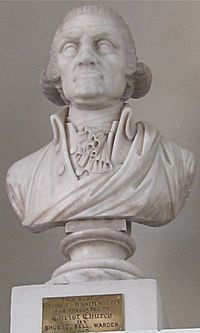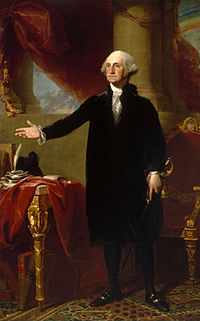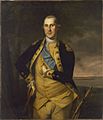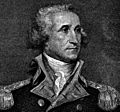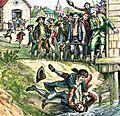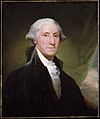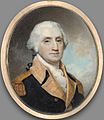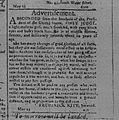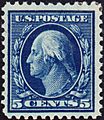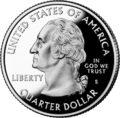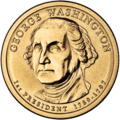George Washington facts for kids
Quick facts for kids
George Washington
|
|
|---|---|
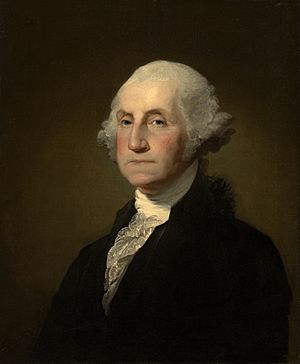 |
|
| 1st President of the United States | |
| In office April 30, 1789 – March 4, 1797 |
|
| Vice President | John Adams |
| Preceded by | Office established |
| Succeeded by | John Adams |
| 7th Senior Officer of the United States Army | |
| In office July 13, 1798 – December 14, 1799 |
|
| President | John Adams |
| Preceded by | James Wilkinson |
| Succeeded by | Alexander Hamilton |
| Commander-in-Chief of the Continental Army | |
| In office June 14, 1775 – December 23, 1783 |
|
| Appointed by | Continental Congress |
| Preceded by | Office established |
| Succeeded by | Henry Knox as Senior Officer |
| Delegate to the Continental Congress from Virginia |
|
| In office May 10, 1775 – June 15, 1775 |
|
| Preceded by | Office established |
| Succeeded by | Thomas Jefferson |
| Constituency | Second Continental Congress |
| In office September 5, 1774 – October 26, 1774 |
|
| Preceded by | Office established |
| Succeeded by | Office abolished |
| Constituency | First Continental Congress |
| Member of the Virginia House of Burgesses |
|
| In office May 18, 1761 – May 6, 1776 |
|
| Preceded by | Unknown |
| Succeeded by | Office abolished |
| Constituency | Fairfax County |
| In office July 24, 1758 – May 18, 1761 |
|
| Preceded by | Thomas Swearingen |
| Succeeded by | George Mercer |
| Constituency | Frederick County |
| Personal details | |
| Born | February 22, 1732 Popes Creek, Colony of Virginia, British America |
| Died | December 14, 1799 (aged 67) Mount Vernon, Virginia, U.S. |
| Political party | Independent |
| Spouse | |
| Children | John (adopted) Patsy (adopted) |
| Parents | Augustine Washington Mary Ball Washington |
| Residence | Mount Vernon |
| Awards | Congressional Gold Medal Thanks of Congress |
| Signature | |
| Military service | |
| Allegiance | |
| Branch/service | |
| Years of service | 1752–58 (Colonial forces) 1775–83 (Continental Army) 1798–99 (U.S. Army) |
| Rank | Colonel (Colonial forces) General and Commander-in-Chief (Continental Army) |
| Commands | Virginia Regiment Continental Army United States Army |
| Battles/wars | French and Indian War |
George Washington (February 22, 1732 – December 14, 1799) was the first President of the United States (1789–1797), the commander in chief of the Continental Army during the American Revolutionary War, and one of the Founding Fathers of the United States.
Contents
Early life
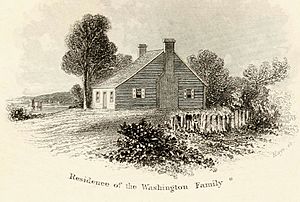
The Washington family was a wealthy Virginia family. George Washington was born on February 22, 1732, at Popes Creek in Westmoreland County, Virginia, and was the first of six children of Augustine and Mary Ball Washington. His siblings were Samuel Washington (1734-1781), John Augustine Washington (1736-1787), Charles Washington (1738-1799), Betty Washington Lewis (1733-1797) and Mildred Washington (1737-1740). George Washington also had four half siblings from his father's first marriage.
His father was a justice of the peace and a prominent public figure who had four additional children from his first marriage to Jane Butler.
The family moved to Little Hunting Creek in 1735, then to Ferry Farm near Fredericksburg, Virginia, on the Rappahannock River, in 1738. When Augustine died in 1743, Washington inherited Ferry Farm and ten slaves; his older half-brother Lawrence inherited Little Hunting Creek and renamed it Mount Vernon.
Washington did not have the formal education his elder brothers received at Appleby Grammar School in England, but he did learn mathematics, trigonometry, and land surveying. He was a talented draftsman and map-maker.
Before the Revolutionary War
Washington became a farmer like his father. His farm was called Mount Vernon. He also worked as a surveyor, measuring land. Washington always wanted to be a soldier and was active in the colonial militia of Virginia. He was sent several times to the "forks of the Ohio River," now called Pittsburgh. His job was to get rid of the French who were trying to take control of the Ohio River Valley.
He failed and many of his men were killed. The fight opened the French and Indian War, bringing Britain into the Seven Years' War. In 1758, Washington was elected to the Virginia legislature.
In 1759, Washington married a widow named Martha Custis. The marriage produced no children.
The Revolution
Washington was a delegate to the First Continental Congress, which was created by the Thirteen Colonies to respond to various laws passed by the British government. The Second Continental Congress chose him to be the commanding general of the Continental Army. Washington led the army from 1775 until the end of the war in 1783. After losing the big Battle of Long Island and being chased across New Jersey, Washington led his troops back across the Delaware River on Christmas Day, 1776, in a surprise attack on Hessian mercenaries at the small Battle of Princeton and Trenton, New Jersey. The British had more troops and more supplies than Washington, however, Washington kept his troops together and won these small battles.
Overall, Washington did not win many battles, but he never let the British destroy his army. With the help of the French army and navy, Washington made a British army surrender at Yorktown, Virginia, in 1781. The Battle of Yorktown was the final major battle of the Revolutionary War. The war officially ended with the Treaty of Paris in 1783.
After the War
When the Revolutionary War ended, Washington was considered a national hero. He was offered a government position that would have been considered a dictatorship over the colonies, but in a surprising move, Washington refused, left the army, and returned to Mount Vernon. He wanted the colonies to have a strong government but did not wish to head that government, nor did he want the colonies to be run by a tyrant.
Washington was one of the men who said the country needed a new constitution. The Constitutional Convention met in 1787, with Washington presiding. The delegates wrote the Constitution of the United States, and all the states ratified it and joined the new government.
Presidency
In 1789, Washington was elected President without any competition, making him the first President of the United States. While Washington did not belong to any political party, he agreed with certain Federalist policies, such as the belief that the country should have a standing army and a national bank. He was re-elected to a second term. After his second term, Washington decided not to run for reelection, despite his popularity remaining high. His decision to stop at 2 terms set a precedent that every President followed until Franklin D. Roosevelt in 1940.
In Washington's farewell address, he warned the country not to divide into political parties and not to get involved in wars outside of the United States. Washington's non-intervention foreign policy was supported by most Americans for over one hundred years. His advice to avoid political parties was completely ignored, as parties were already forming at the time of his speech.
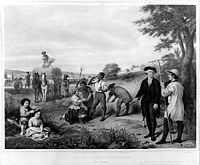
Retirement
Washington went back home to Mount Vernon (Virginia) after his second term ended in 1797. He died 2 years later, on December 14, 1799, in Mount Vernon, at the age of 67, from pneumonia.
Wealth
George Washington owned a large amount of farmland, where he grew tobacco, wheat, and vegetables. Washington also owned more than 100 slaves, who were freed upon his death. He did not have much money in cash and had to borrow money while he was President. At his death, Washington's estate was worth over $500,000.
False Teeth
George Washington's teeth started to fall out by the time he was 22 years old. By the time he became President, he had only one tooth left. He eventually had it pulled, and he kept it in a gold locket attached to his watch chain. It is a common misconception that Washington had wooden teeth. People thought this because he tried to keep his false teeth that were made of elk's teeth or ivory clean in an unusual way. He soaked them in wine. Rather than keeping them clean, this caused stains in the hairline fractures that looked like the grain in a piece of wood. When the time came for the President to have his portrait painted, cotton was pushed under his lips to make him look as if he had teeth. The cotton made his mouth puff out, as is seen in the picture on the US $1 bill.
George Washington quotes
- “99% of failures come from people who make excuses.”
- “It is better to be alone than in bad company.”
- “A free people ought not only to be armed but disciplined."
- “Human happiness and moral duty are inseparably connected.”
- “If freedom of speech is taken away, then dumb and silent we may be led, like sheep to the slaughter.”
- “Labor to keep alive in your breast that little spark of celestial fire called conscience.”
- “A sensible woman can never be happy with a fool.”
- “Paper money has had the effect in your state that it will ever have, to ruin commerce, oppress the honest, and open the door to every species of fraud and injustice.”
Interesting facts about George Washington
- George Washington's birthday was actually 11 days earlier than it is listed. When the colonies switched calendars from the Gregorian to the Julian, the date was changed.
- George did not have a middle name.
- George powdered his real hair rather than wearing a wig.
- In 1976, George Washington was made the highest-ranking man in the military: The General of the Armies of the United States.
- It is thought that George Washington may have died because a doctor who was trying to help him (Washington had pneumonia) took too much blood from his body in a process called bloodletting.
- He wrote somewhere between 18,000 and 20,000 letters in his lifetime. It would take 50-55 years to write that many letters if you wrote one letter per day.
- George Washington loved dogs.
- George was the only President to go into battle while serving as the President.
Images for kids
-
Lieutenant Colonel Washington holds night council at Fort Necessity
-
Washington the Soldier: Lieutenant Colonel Washington on horseback during the Battle of the Monongahela (oil, Reǵnier, 1834)
-
Colonel George Washington, by Charles Willson Peale, 1772
-
Martha Washington based on a 1757 portrait by John Wollaston
-
General Washington, Commander of the Continental Army by Charles Willson Peale (1776)
-
Washington Crossing the Delaware, Emanuel Leutze (1851)
-
The Passage of the Delaware, by Thomas Sully, 1819 (Museum of Fine Arts, Boston)
-
Washington Rallying the Troops at Monmouth, Emanuel Leutze (1851–1854)
-
French King Louis XVI allied with Washington and Patriot American colonists
-
Siege of Yorktown, Generals Washington and Rochambeau give last orders before the attack
-
General George Washington Resigning His Commission, by John Trumbull, 1824
-
Shays' Rebellion confirmed for Washington the need to overhaul the Articles of Confederation.
-
John Jay, negotiator of the Jay Treaty
-
Seneca chief Red Jacket was Washington's peace emissary with the Northwestern Confederacy.
-
USS Constitution: Commissioned and named by President Washington in 1794
-
Miniature of George Washington by Robert Field (1800)
-
George Washington's bookplate with the Coat of arms of the Washington family
-
Runaway advertisement for Oney Judge, enslaved servant in Washington's presidential household
-
Washington, the Constable by Gilbert Stuart (1797)
-
Washington Monument, Washington, D.C.
-
Washington–Franklin issue of 1917
-
Washington quarter dollar
-
George Washington Presidential one-dollar coin
-
Washington on the 1928 dollar bill
See also
 In Spanish: George Washington para niños
In Spanish: George Washington para niños


